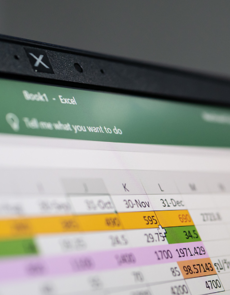6 Production Planning and Control Tools Your Manufacturing Business Needs To Succeed
Production planning tools are fundamental to the efficiency, competitiveness and long-term growth of manufacturers. Whether it’s on the factory floor or head office, teams need to be supported by the right technology to process orders, plan schedules and deploy resources, all while keeping downtime and waste to a minimum.
This guide takes a look at six production planning and control tools designed to streamline and sustain high performance across your manufacturing business.
What Are Production Planning and Control Tools?
Production planning and control tools are used in the manufacturing industry to manage and streamline production processes. They help manufacturers streamline workflows, minimise costs and control production activities from end to end.
Production planning and control software should underpin collaboration across functions and departments; different tools also have niche purposes within the production cycle.
Ideally, every tool in your manufacturing tech stack should offer seamless integration, so that systems connect with each other and automatically sync data without manual intervention.
This is vital for effective production planning and control as it enables your teams to work from a single source of truth, free from the risk of data entry mistakes or poor version control.
Why Production Planning Is So Important
The end goal of production planning is to establish a realistic and accurate schedule that covers all areas of production (including maintenance, quality control) and produces minimal waste. High-performance manufacturers also commit time to forecasting, production modelling and contingency planning in order to pre-empt unexpected issues and delays – and avoid costly downtime as a result.
Effective production planning helps manufacturers reduce costs by optimising the use of equipment, materials and labour, while also avoiding scenarios in which resources are either overstretched or underutilised. Avoiding bottlenecks and delays across key processes maximises productivity and delivers shorter lead times for client orders.
Supply chains, levels of digitisation and industry regulations are constantly evolving, which is why more and more manufacturers are looking for alternatives to Excel and other legacy tools that are difficult to upgrade or integrate with other systems. It’s worth auditing your tech stack on a regular basis to spot recurring inefficiencies and ensure all bases are covered.
6 Essential Production Planning and Control Tools
For any manufacturer aiming to optimise workflows, ensure efficient use of resources and deliver orders at pace, these six essential production planning and control systems can play a critical role:
Production Planning Software
Production planning software helps manufacturers create and adjust production schedules, optimise the use of resources and manage capacity.
The main benefit of production planning software is that it streamlines and automates each stage of the planning process, and all teams are working from one plan. That reduces the likelihood of human error, enhances coordination across departments and improves overall productivity. Whether you opt for a free or paid production planning system, it’s worth weighing up your options to find the best manufacturing planning software to match your business needs.
Material Requirements Planning Software (MRP)
MRP systems manage the manufacturing process from goods in to despatch, determining material requirements and production activities. These systems take into account sales orders, production schedules, inventory levels and bill of materials to
ensure that the right materials are available at the right time.
As well as avoiding production delays and material shortages, a material requirements planning software helps manufacturers reduce waste and cash tied into inventory by optimising materials procurement. They also provide valuable insights into inventory usage patterns, which feeds back into demand forecasting and inventory management.
Demand Forecasting Software
Demand forecasting software turns historical sales data, market trends and statistical algorithms into accurate predictions for future demand. It is now considered a vital tool for production planning because it enables manufacturers to anticipate customer needs and adapt their production schedules accordingly.
When used with MRP software, demand forecasting tools enable better inventory management and reduce the risk of overproduction or stock-outs during key periods. It’s also a valuable tool when simulating different scenarios and identifying the best strategies to deal with changes in demand or supply chain disruptions.
Inventory Management Software
Inventory management software tracks inventory levels, orders, sales and deliveries. It gives businesses real-time visibility into stock levels and helps manage reordering processes.
This ensures materials are always available without the need to hold excessive inventory. It reduces carrying costs by maintaining optimal inventory levels and minimises the risk
of stock-outs disrupting production. It also improves cash flow management by avoiding overinvestment in inventory.
Manufacturing CRM Software
Customer relationship management systems (CRM) enable manufacturers to manage interactions with customers, from order processing to after-sales support. These tools also collect and analyse customer data to improve service quality and foster long-term relationships.
The main goal of an effective manufacturing CRM software is to enhance customer experience and provide a higher quality of service. Data from these systems helps in understanding customer preferences and demand patterns, which can inform production planning and forecasting.
CRM tools can also improve coordination between sales and production teams, ensuring that customer orders are delivered accurately and on time. Estimates and quotations from sales based on accurate costings from production also keep a tight control on margins.
Quality Control Software
For manufacturers working to strict quality standards and regulatory requirements, quality control systems help to monitor the quality and consistency of all goods produced.
These systems are crucial to document quality standards, conduct audits, manage defects and irregularities, and enable quick interventions in the event that something goes wrong. This feeds into a culture of continuous improvement for manufacturers that are looking to minimise waste and reduce costs, while also ensuring a superb quality of product and higher customer satisfaction.
How to Implement Production Planning Tools in Your Manufacturing Business
Implementing production planning and control tools in your manufacturing business requires a strategic approach to ensure successful adoption and maximum benefits. Here are the key initial steps you should be looking to follow:
- Audit your current processes – The first step should be a detailed evaluation of your existing workflows, resource utilisation and production bottlenecks. This helps identify specific areas where production planning tools can have the most significant impact.
- Set benchmarks – Before you roll out any new systems, it’s a good idea to start benchmarking key performance indicators (KPIs) across key areas of your operations. The idea is to set baseline levels of output, efficiency, costs, lead times and other metrics related to productivity, all of which can be monitored over time to gauge the effectiveness of new tools.
- Provide effective training – You need to offer comprehensive training for all employees who will use the new tools. This training should cover not just the technical aspects of the tools but also how they integrate with existing processes and workflows. Engaging employees early in the process and obtaining their feedback can facilitate smoother transitions and increase buy-in.
- Conduct a pilot test – Running a pilot phase before full-scale implementation can be useful to spot potential issues early and forecast the impact a new system will have on production. Make sure to select a manageable segment of your production process to test the tool’s effectiveness and minimise risk.
- Measure progress – Once you’ve launched the new system, it’s important to monitor performance data so you can compare against previous benchmarks, track progress and make necessary adjustments. Regularly reviewing the tool’s impact on your operations is also crucial to demonstrate ROI and share results with senior leaders.
Streamline Your Manufacturing Production Planning With Access Orchestrate
It pays to do your research when looking to invest in production planning and control tools to match the specific needs of your manufacturing business.
Key tools like production planning software, MRP systems and inventory management platforms can help you to secure significant cost savings and improve your overall operational efficiency and productivity.
Get in touch with us today to talk to our manufacturing software specialists about your current challenges, and learn more about how our production planning and control tools can drive maximum efficiency across your operations.




